Lacquer is a varnish produced from the resin of an East Asian tree called Rhus verniciflua (syn. Toxicodendron vernicifluum), or lacquer sumach. The tree produces, when the bark is scratched, a white, poisonous secretion that can be refined and filtered, coloured and then be used to coat objects. Lacquer is applied in several layers and ideally preserves objects of wood or bamboo against decay. The material is waterproof and resists UV light and heat. Dried lacquer coatings are extremely hard and must be worked with knives when carving or integrating intarsia (pieces of gold, silver, jade, ivory or mother-of-pearl) into the lacquer coating. The addition of colourants gives lacquer a beautiful appearance. If polished, lacquerwork objects have a smooth and complaisant surface.
The Chinese character for lacquer (qi 漆) is a picture of liquids (氽) dropping from a tree (木): 桼. The standard form of the character adds water 氵 as the radical.
The discovery of lacquer as a protective or decorative medium happened in prehistoric times, and objects from the Hemudu 河姆渡, Majiabang 馬家浜 and Liangzhu 良渚 cultures in the Lower Yangtze region prove its early use for the protection and decoration of wooden and basket-like objects. In many cases the wooden object base has disappeared and only parts of the lacquer coating have survived. Early lacquerwork art is a type of painting art (suxiu 素髹 "monochrome lacquering", caixiu 彩髹 "multi-coloured lacquering").
Objects of various uses were coated with several layers of lacquer and then painted in lacquer (miaoqi 描漆) with geometrical designs, and sometimes simple pictorial scenes. While the earliest lacquer coatings were directly applied to the base, the invention of a lacquer base of a mixture of textile and crude lacquer around c. 500 BCE substantially raised the stability of the coating. Painted lacquer objects of wood came to replace the much heavier ritual bronze vessels.
Han period 漢 (206 BCE-220 CE) lacquer art reached a proto-industrial stage, and some items were marked with the names of craftsmen or workers carrying out various steps of the production process, from the manufacture of the base model to the final polishing. The range of lacquered objects included dinnerware, parts of chariots or horse's harness, armour and weaponry, racks for clothes or musical instruments, vanity cases, and also coffins. Occasionally Han period lacquerware is decorated by inlaid metal pieces (e.g. silver, yinkou 銀釦), or gold foil (jinbo 金箔 or 金薄) pasted on the lacquer ground.
Lacquer painting flourished until ca. 300 CE and probably influenced the emergence of the art of painting on paper or silken scrolls around that time. Lacquer was also applied to metal objects and later to porcelain, less for protective, but more for decorative purposes. This technique is found, in combination with mother-of-pearl (luodian 螺钿) in inlays, on the back sides of metal mirrors during the Tang period 唐 (618-907).
During that time, the art of lacquerwork spread to Korea and Japan, where it took to its own ways, particularly in Japan, which eventually became the master of the art of lacquerwork. Only a small number of lacquerware objects is preserved from the Tang period.
Lacquerwork techniques were enhanced during the early Song period 宋 (960-1279), when monochrome coatings were fashionable, not only in lacquered objects, but also in glazed chinaware. Early Song period lacquerware worked also with the new technique of multicoloured lacquer fill-ins, a method by which patterns in the lacquer coating were cut out, and then filled with lacquer paste of different colours (tian caiqi 填彩漆), or gold paste (qiangqin 戧金). This technique is called tianqi 填漆. In engraved lacquerwork thin cut-out lines can be filled either with lacquer paste of various colours (diaotian 雕填), or with mother-of-pearl inlays, with precious stones or various metals (baibaoqian 百寶嵌). In order to obtain a smooth surface, the whole object was covered with a final transparent lacquer film (zhuoqi 罩漆).
The technique of lacquer painting resorted to the new mode of adding gold powder to the varnish (miaojin 描金). Another technique used to apply the lacquer coating in such a way that layers of differing thickness formed patterns on the surface, like flowers, landscapes or other scenes. This method is called duiqi 堆漆 "heaped-up lacquer". The edges of the individual parts of the duiqi relief are smooth.
During the Yuan period 元 (1279-1368), a new technique emerged, namely carved lacquerwork (diaoqi 雕漆). For the purpose of carving lacquer, the coating was extremely thick, with up to 50 layers or more of lacquer. Such art objects were accordingly relatively expensive. Using hard knives, craftsmen carved various floral patterns and scenes into the lacquer coating. Carved lacquer (called tihong 剔紅 if the upper part of the coating is red) became very popular. The thickness of the coating made it possibly to give the layers different colours, so that the base of a carved-out scene might have a different colour than the parts of the foreground (e.g. black or brown background and red foreground; rarely vice versa).
Carved lacquerwork with many layers of alternating colours is called tixi 剔犀, yet this term is also used to designate lacquerwork with thin layers of different colours in which the surface is irregularly polished down so that a blurry, blotchy or marbled pattern with stains of different colours (xipi 犀皮 "skin of a rhino") appears.
Multi-layer carved lacquerwork is often realized with the popular guri 倶利 motif (a Japanese term used in the West, while the equivalent Chinese term is tixi), a kind of abstract cloud pattern.
Multipart lacquer screens were often decorated with mother-of-pearl inlays, but much more often with paintings, in which defined areas were given just one colour (kuancai 款彩). In the West, these were known as Coromandel lacquer screens because they were traded via the Coromandel Coast in India.
Some local producers, mainly in the province of Fujian, use the technique of body-less lacquerware (tuotai qiqi 脫胎漆器) in which the base model is made of paper or linen (jiazhu 夾紵) and removed when the lacquer coating is dry.
The climax of Chinese lacquer art is commonly said to be found during the mid- and late Ming period.
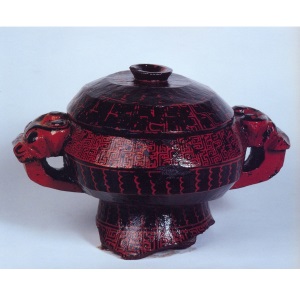 |
Fig. 1. Gui 簋–type vessel with spiral patterns, Warring States period 21 cm high, excavated in 1988 in Dangyang 當陽, Hubei, held by the Museum of Yichang 宜昌, Hubei Source: Zhu Jiapu 朱家潽, Xia Gengqi 夏更起, ed. (1993). Zhongguo qiqi quanji 中國漆器全集 (Fuzhou: Fujian meishu chubanshe), Vol. 1, no. 31. |
| The body of the vessel is made of wood and imitates the shape of the ancient gui-type bronze vessels, with a belly corpus, two handles at the side, a cover, and a large foot. The upper part of the handles has the shape of ox heads. While the inner part of the vessel is lacquered in red, the outer part has a red base, with decorations in black. The spiral pattern on the bands running around the belly and the foot of the vessel imitates the cloud patterns of the bronze vessels. The other parts of the object carry wave patterns, strips and triangular shapes. | |
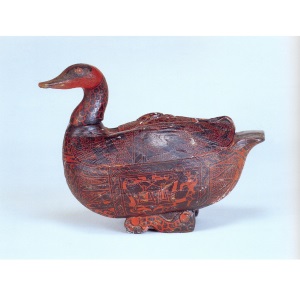 |
Fig. 2. Duck-shaped vessel with images of musicians, Warring States period 10.3 cm × 6.7 cm, height 8.6 cm, excavated in 1978 in Suixian 隨縣, Hubei, from the tomb of Marquis Yi of Zeng 曾乙侯, held by the Provincial Museum of Hubei Source: Zhu Jiapu 朱家潽, Xia Gengqi 夏更起, ed. (1993). Zhongguo qiqi quanji 中國漆器全集 (Fuzhou: Fujian meishu chubanshe), Vol. 1, no. 57. |
| The wooden body of the duck-shaped container was produced in two parts that were later joined. The inner part is lacquered in red, and the outer part with a black base, and is decorated with red patterns imitating feathers, and with zigzag stripes. At both sides of the duck, scenes of musicians are painted, the one playing bells hanging from a rack, the other one a large drum. The latter scene includes also a dancer. | |
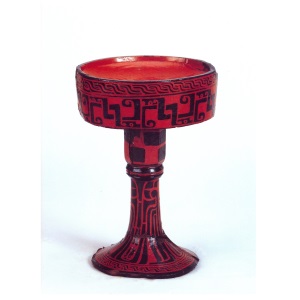 |
Fig. 3. Dou 豆–type vessel with bird and cloud patterns, Warring States period 15.8 cm diameter, height 21.6 cm, excavated in 1995 in Jiangling 江陵, Hubei, held by the Archaeological Institute of the Province of Hubei Source: Zhu Jiapu 朱家潽, Xia Gengqi 夏更起, ed. (1993). Zhongguo qiqi quanji 中國漆器全集 (Fuzhou: Fujian meishu chubanshe), Vol. 1, no. 70. |
| The body of the vessel is made of wood and composed of three parts (foot, shaft, cup) and painted with the basic colour red. The cup has a very thick base and is covered with black spiral cloud patterns, the octagonal shaft is painted with black square patterns, and the funnel-shaped foot has decorations in the shape of bird feathers, and in the lowest part a band of spirals. | |
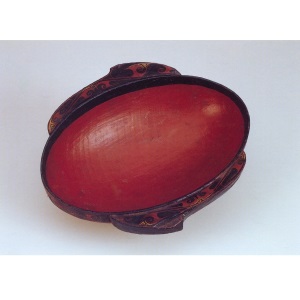 |
Fig. 4. Ear cup with bird and cloud patterns, Warring States period 17.6 cm × 16.4 cm, height 5 cm, excavated in 1995 in Jiangling 江陵, Hubei, held by the Archaeological Institute of the Province of Hubei Source: Zhu Jiapu 朱家潽, Xia Gengqi 夏更起, ed. (1993). Zhongguo qiqi quanji 中國漆器全集 (Fuzhou: Fujian meishu chubanshe), Vol. 1, no. 84. |
| The wooden body is composed of several parts. The inner side of the oval part containing the beverage is lacquered in red, while the two ear-shaped handles as well as the outer side of the body carry spiral patterns and shapes of bird feathers in black and yellow lacquer. The two “ears” on the side gave this popular type of cup its name (erbei 耳杯). | |
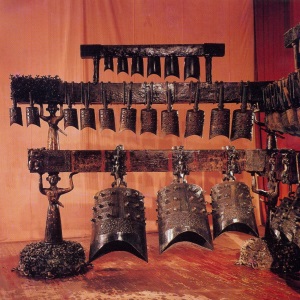 |
Fig. 5. Lacquered rack of a set of bells, Warring States period Long rack 708 cm × 265 cm, short rack 335 cm × 273 cm, excavated in 1978 in Suixian 隨縣, Hubei, from the tomb of Marquis Yi of Zeng 曾乙侯, held by the Provincial Museum of Hubei Source: Zhu Jiapu 朱家潽, Xia Gengqi 夏更起, ed. (1993). Zhongguo qiqi quanji 中國漆器全集 (Fuzhou: Fujian meishu chubanshe), Vol. 1, no. 99. |
| The rack itself is made of wood and metal parts and consists of two parts, both with three stories, with large bells on the lowest one, and small ones hanging on the highest beam. The rack, made of 51 parts, is hold by three bronze pillars formed in the shape of persons. The beams of the rack are lacquered in black, and decorated with spirals, bird-shaped patterns, and triangles, in red and yellow colour. In many places, the tone of the bell is marked by an inscription. | |
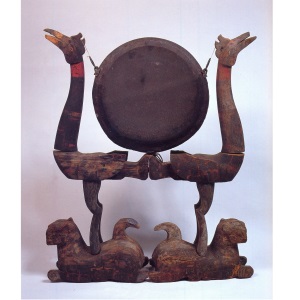 |
Fig. 6. Small drum with rack in the shape of birds and tigers, Warring States period Diameter of the drum 38.4 cm total height 86 cm, excavated 1988 in Jiangling 江陵, Hubei, held by the Museum of Jiangling Source: Zhu Jiapu 朱家潽, Xia Gengqi 夏更起, ed. (1993). Zhongguo qiqi quanji 中國漆器全集 (Fuzhou: Fujian meishu chubanshe), Vol. 1, no. 103. |
| The rack consists of several parts carved of wood. The base is shaped as two tigers, and the upper part hold the drum, in the shape of two long-necked birds. The flat drum consists of three bronze rings tied to the rack by silk threads. The rack is lacquered black, and decorated with red and yellow patterns, the tigers with spots, the birds with feathers, and the outer rim of the drum with triangles and clouds. | |
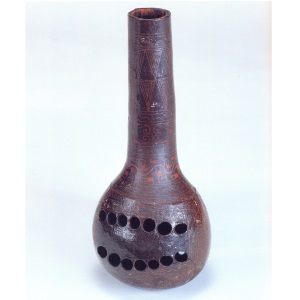 |
Fig. 7. Mouth organ with various patterns, Warring States period 20.8 cm, length of organ piece 20.2 cm, excavated in 1978 in Suixian 隨縣, Hubei, from the tomb of Marquis Yi of Zeng 曾乙侯, held by the Provincial Museum of Hubei Source: Zhu Jiapu 朱家潽, Xia Gengqi 夏更起, ed. (1993). Zhongguo qiqi quanji 中國漆器全集 (Fuzhou: Fujian meishu chubanshe), Vol. 1, no. 109. |
| The body of this mouth organ (sheng 笙) is made of gourd (pao 匏, resonator) and consists of two pieces. Of the bamboo pipes, only fragments are preserved. The whole piece is constructed like modern mouth organs, with an opening in the pipes that is covered with the fingers to produce tones. The two rows of pipes of different length should stick in the openings of the gourd resonator. Resonator and pipes are lacquered with a black base, decorated with various patterns (triangles, spirals, braids, etc.) in red colour. The mouth organ belongs to a set of musical instruments found in the tomb. | |
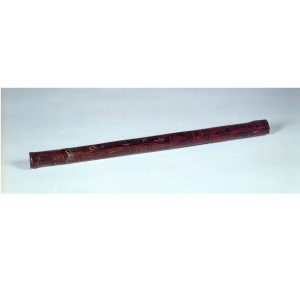 |
Fig. 8. Flute with various patterns Warring States period 29.3 cm, diameter 1.7-1.9 cm, excavated in 1978 in Suixian 隨縣, Hubei, from the tomb of Marquis Yi of Zeng 曾乙侯, held by the Provincial Museum of Hubei Source: Zhu Jiapu 朱家潽, Xia Gengqi 夏更起, ed. (1993). Zhongguo qiqi quanji 中國漆器全集 (Fuzhou: Fujian meishu chubanshe), Vol. 1, no. 110. |
| The body of this flute (chi 箎) is made of a single section of a bamboo stalk. The holes on both ends have an oval shape. The flute seems to have been end-blown. The body of the instrument has five holes for regulating the sound. The flute is lacquered with a black base and decorated with various patterns (triangles, spirals, braids, clouds, rhombs, etc.) in red and yellow colour. The flute belongs to a set of musical instruments found in the tomb. | |
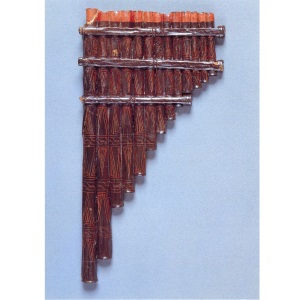 |
Fig. 9. Pan flute with various patterns, Warring States period Longest pipe 22.5 cm, width 11.7 cm, excavated in 1978 in Suixian 隨縣, Hubei, from the tomb of Marquis Yi of Zeng 曾乙侯, held by the Provincial Museum of Hubei Source: Zhu Jiapu 朱家潽, Xia Gengqi 夏更起, ed. (1993). Zhongguo qiqi quanji 中國漆器全集 (Fuzhou: Fujian meishu chubanshe), Vol. 1, no. 111. |
| The body of this pan flute (paixiao 排簫) is made of 13 bamboo flutes of different length. The pipes are tied together by threads and fixed by three transversal sticks of bamboo. The holes, by which the pipes are blown, are arranged in a horizontal line, while the whole body of the flute has the shape of a wing. The whole flute is lacquered with a black base and decorated with various patterns (triangles, spirals, braids, clouds, rhombs, etc.) in red colour. The upper part of the flute is painted red. The flute belongs to a set of musical instruments found in the tomb. | |
 |
Fig. 10. Rack with various patterns, Warring States period 264 cm × 181 cm, excavated in 1978 in Suixian 隨縣, Hubei, from the tomb of Marquis Yi of Zeng 曾乙侯, held by the Provincial Museum of Hubei Source: Zhu Jiapu 朱家潽, Xia Gengqi 夏更起, ed. (1993). Zhongguo qiqi quanji 中國漆器全集 (Fuzhou: Fujian meishu chubanshe), Vol. 1, no. 144. |
| The rack, made of wood, consists of three parts, namely two round feet, two posts, and a transversal beam. Exactly in the middle of the round posts, square pieces are inserted. The ends of the transversal beam are formed like the heads of beasts (birds or snakes). The ground of all parts is lacquered in black colour, and decorated with various patterns (triangles, clouds, spirals, bands), with black sections in-between. The animal heads are decorated with eyes, scales/feathers etc. | |
 |
Fig. 11. Flat part of a quiver, Warring States period 23.5 cm × 18-22 cm, excavated in 1965 in Jianling 江陵, Hubei, held by the Provincial Museum of Hubei Source: Zhu Jiapu 朱家潽, Xia Gengqi 夏更起, ed. (1993). Zhongguo qiqi quanji 中國漆器全集 (Fuzhou: Fujian meishu chubanshe), Vol. 1, no. 155. |
| The flat piece is made of wood. It is assumed that it was part of a quiver. The whole body consists of several parts glued together. The original surface is carved through as a relief (fudiao 浮雕) to form one bird swooping down, two phoenixes facing the centre, and two panthers looking to the outer side of the scene. The carving is realized exactly symmetrically. The basic colour on the animals is black, and red colour imitates feathers and spots. The upper and lower parts of the piece are lacquered red. The upper part is decorated with a snake-shaped relief. The sides are decorated with geometrical patterns. | |
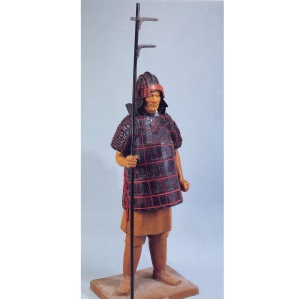 |
Fig. 12. Lacquered armour, helmet and halberd, Warring States period Armour 84 cm × 48 cm, length of the sleeves 40 cm, lower circumference of jacket 156 cm, excavated in 1978 in Suixian 隨縣, Hubei, from the tomb of Marquis Yi of Zeng 曾乙侯, held by the Provincial Museum of Hubei Source: Zhu Jiapu 朱家潽, Xia Gengqi 夏更起, ed. (1993). Zhongguo qiqi quanji 中國漆器全集 (Fuzhou: Fujian meishu chubanshe), Vol. 1, no. 156. |
| The body of the armour is made of leather and consists of the helmet, a cuirass, sleeves, and a jacket. The 201 parts of the armour tied together with red silk threads. The helmet, made of 18 pieces, has a crest, a front piece, and side wings. The cuirass is made of 23 pieces, including the breast, the back, shoulders, and side parts to protect the ribs. The two sleeves are made of 52 pieces each, including two standing wings protecting the neck from the side. The jacket consists of four rows of 14 large square pieces. All “scales” of the armour are lacquered in black, without decoration. The pole of the halberd (ji 戟, length c. 250 cm) is enwinded with bamboo strips. | |
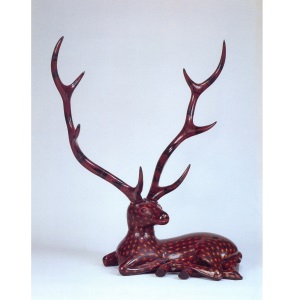 |
Fig. 13. Decorative object in the shape of a stag, Warring States period Length 45 cm, height of the body 27 cm, total height 77 cm, excavated in 1978 in Suixian 隨縣, Hubei, from the tomb of Marquis Yi of Zeng 曾乙侯, held by the Provincial Museum of Hubei Source: Zhu Jiapu 朱家潽, Xia Gengqi 夏更起, ed. (1993). Zhongguo qiqi quanji 中國漆器全集 (Fuzhou: Fujian meishu chubanshe), Vol. 1, no. 181. |
| The object is composed of four parts, namely the wooden body and head of the animal, and two real antlers. Head and body are joined by pegs. The stag is lying in a very natural shape. The antlers are somewhat too large in relation, but the whole appearance of the object is very pleaisant and demonstrates the skills of its creator. Face and the hooves are modeled with much detail. The ground is lacquered black, and the fur decorated with yellow-red petals and red dots. The surface is polished. The antlers are decorated with geometrical patterns in red and black. | |
 |
Fig. 14. Figurines of courtiers, Warring States period Height c. 45 cm, excavated in 1992 in Qianshan 潛山, Anhui, held by the Archaeological Institute of Anhui Source: Zhu Jiapu 朱家潽, Xia Gengqi 夏更起, ed. (1993). Zhongguo qiqi quanji 中國漆器全集 (Fuzhou: Fujian meishu chubanshe), Vol. 1, no. 186. |
| The figurines are made of wood and carved in course reliefs showing in crude shape the faces, clothes, and posture. No headgear is indicated. The clothes show traces of black lacquering. | |
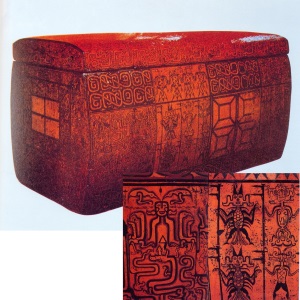 |
Fig. 15. Inner coffin, Warring States period 249 cm × 127 cm, height 132 cm, excavated in 1978 in Suixian 隨縣, Hubei, from the tomb of Marquis Yi of Zeng 曾乙侯, held by the Provincial Museum of Hubei Source: Zhu Jiapu 朱家潽, Xia Gengqi 夏更起, ed. (1993). Zhongguo qiqi quanji 中國漆器全集 (Fuzhou: Fujian meishu chubanshe), Vol. 1, no. 188. |
| The cover, the four side planks, and the bottom are made of wooden boards and hold together by pegs. The basic colour on the inner and outer sides of the coffin in red lacquer. On the outer side, many decorations are added in yellow and black colour. The decorations consist of geometrical patterns and cloud and spiral ornaments, but also of many figures, like birds, phoenixes, dragons, snakes, stags, and composite beings, for instance, birds with beast faces holding halberds. On all sides, part of the decoration seems to depict a kind of winged door. | |